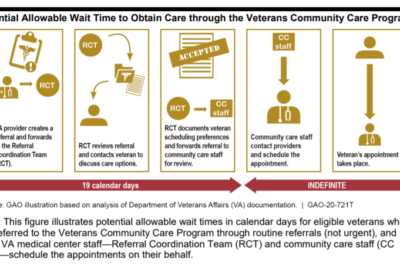

Veterans currently experience long wait times for pain management treatment. Allowing nurse anesthesiologists to treat them would speed the process up.
Best listening experience is on Chrome, Firefox or Safari. Subscribe to Federal Drive’s daily audio interviews on Apple Podcasts or PodcastOne.
We start with another view of VA and care appointments long wait times for certain types of treatment continuing to occur at the Veterans Health Administration. Among the conditions for which veterans wait is pain management. My next guest says that in California the wait for pain care can last 78 days. For why this is so and how VHA can possibly fix it, the Federal Drive with Tom Temin turned to former Mississippi Senator and Majority Leader Trent Lott.
Interview transcript:
Trent Lott: I appreciate your taking the time to talk about this important issue for our veterans and our nurse anesthetists.
Tom Temin: Right. And you are speaking on behalf of the American Association of Nurse Anesthesiology. And I guess they’ve got a lot of members at VA, is that correct?
Trent Lott: That’s right. And I’ve been following their activities. Going back to when I was in the Senate, I used to meet with them, because I realized it was a tremendous need for what they provide because we didn’t have enough, you know, doctors to be on site for all of our veterans’ needs. So I’ve been working on this for quite awhile.
Tom Temin: As anesthesiologists, then they would work both in surgical situations, but also in pain management, say for some chronic situations, is that a fair way to set it?
Trent Lott: Yes. And what’s really important about that is, as the situation is now without the nurse activities and involvement, a lot of our veterans that have pain management needs are having to wait days as long as 78 days as you said in California, even longer than that in Kansas. So this is a problem in search of a solution, which is obvious. We’ve been using nurses at all of our military activities and branches going back to World War I. So why the VA has not stepped up and done this, I don’t understand. But I think they’re getting close to actually making the decision to involve these nurse anesthetists more.
Tom Temin: And a few years ago, didn’t VA extend a lot of practice privileges to other areas of high level nurses, but not the anesthesiology ones?
Trent Lott: Yes, that’s correct. Or they did do it on a temporary basis, I believe, but they have a lot of needs, and not enough professionals to look after our veterans. And of course, part of the problem was VA was underfunded. But to their credit up in Congress, they did pass over the last couple of years that PACT Act, which is actually going to make more veterans eligible for care. So we’re going to need what these nurse anesthetists do even more.
Tom Temin: And so therefore, for VA, the wait times is a result of capacity simply just to take in and administer what it is that the pain management people require?
Trent Lott: Right. It’s not capacity in terms of building, its capacity in terms of doctors and nurses being allowed to do what they can do. So that the veterans can get the care they need desperately, and particularly to talk about pain management. This is not something you want to wait on.
Tom Temin: Right, and pain management then requires at this point, only MD anesthesiology practitioners, right?
Trent Lott: Yeah. Right. In the Veterans Administration. Now, that’s not true in military branches. And it really is applicable only to the VA where it’s needed probably the most.
Tom Temin: Now the MISSION Act put a lot of care availability out in the private sector. Can someone get care using a nurse anesthesiologist in the private sector, under the MISSION Act program?
Trent Lott: The previous VA administrator had taken some action to help allow the veterans to be able to get care outside the VA system where there was an urgent need and that was a positive thing.
Tom Temin: And what’s your sense of like how many veterans they serve? Nine million veterans at VA, there’s a pretty good population. It’s always growing and morphing. What’s your sense of the numbers of people that might be affected by this? Just need to wait for pain management?
Trent Lott: Well, I don’t have a specific number. But I think it you know, it’s it’s significant, because we do have so many veterans, and many of them are getting older now. Of course, the World War II veterans pretty much gone, but we’ve got the Korean and Vietnam, and more recently, Afghanistan, Iraq. We got a lot of veterans out there that have unique needs for this medical care that the VA should be able to provide, but is not able to, because one thing they don’t have these certified nurses actively involved. Now, let me just say again, the VA, we have talked to the Secretary of the Veteran Administration about this. We’ve talked to the top doctor, they have a process in place to look at can they do this and and how and when. We are under the impression that by the end of the year, they’re gonna make this decision. It’s an easy decision, I think, but they need to go ahead and do it.
Tom Temin: We’re speaking with former Mississippi Senator Trent Lott in his capacity as representing the American Association of Nurse Anesthesiology and long-term abiding interest in veterans affairs generally, I think it’s fair to say and what is your sense of the delay? What do they tell you? Why not just make what seems to be a fairly manifest decision?
Trent Lott: Well, you know, the government never acts fast, makes a decision quickly they go through a thorough process. But I have to confess also, the doctors resist this very aggressively in the private sector, as well as within the government and within the VA, because their attitude is, “Well, geez, if these nurses can do this, when we’re not even in the building, you know, what will our role be?” The problem is, quite often the doctor is not in the room anyway, or even in the building when a nurse administers the anesthesia. So, but they resist, the previous Veterans Affairs Secretary told me that when he suggested he was gonna make this move, he got a call for Vice President Pence, from the White House who “said, What are you doing? The doctors in Indiana are raising all kinds of Caine.” So I don’t want to condemn the doctors that what they do is very important, but the nurses are there. They’re the ones that most of the time actually administer the anesthesia. We have a need for what they do. And they have proven throughout history, that they can do it professionally, effectively and safely.
Tom Temin: Any signals from the current VA Secretary, Mr. McDonough? Because Mr. Wilkie, they don’t agree on much from what we can tell, but this might be something they agree on?
Trent Lott: Well, I don’t know. You know, I was referring to Secretary Wilkie as the previous secretary. I know, obviously, McDonough very well, he worked in the Senate when I was there with my good friend Thom Daschle. And I know that Tom has spoken to him about this. We don’t want to put inappropriate or undue pressure on him. But he is aware that there’s a great need here. And I have enough faith in him as an individual. You know, he’s got to deal with the bureaucracy. He’s got to deal with the doctors within the VA, but I’m on hold. And I believe maybe they’re gonna make the right decisions soon.
Tom Temin: And the other veterans issues that you’re working on while we have you?
Trent Lott: Well, you know, I was on the Armed Services Committee when I was in the Senate and, you know, armed services leads to the veterans. We have just seen a report from the Heritage Foundation that we’re not meeting our needs in terms of numbers of ships, or the kinds of ships that we’re constructing now. And by the way, we build a lot of them in my hometown of Pascagoula, Mississippi. We build destroyers, cruisers, LPDs and LHAs. Also, we’re short about 20,000 army recruits, the whole Air Force is struggling to keep and maintain pilots. So we have a tremendous need now in the military, which leads to pressures on the military people, which leads to complications when you become a veteran. So we need to take a serious look. Next year, they have got to pay attention to our military strength. Only the Marine Corps is up to standard of what we need. So there’s a big need there. We don’t take care of our military men and women, then we’re gonna have more problems with veterans.
Tom Temin: Yeah, the recruiting question is a complicated one, because it’s sociology, it’s economics. It’s a million different factors, but young people, just the ones that are eligible in the first place, which is not even the majority of people of that age, then they’re not choosing this. And I guess that’s the root of the problem that no one can quite figure out.
Trent Lott: Well, one time I visited the Keesler Air Force Base in Biloxi, Mississippi, I was really impressed and somewhat surprised at how high tech these airmen are these young airmen, they are high tech geeks these days. And when you start to realize that somebody in Florida can launch a Hellfire missile in Iraq, you know, you got to be technologically advanced. So the Generation X and Z, they are very inclined to be technologically advanced boy, we need what they can do.
Tom Temin: Well, December 2, there’s a new bomber arriving on the scene, at least six prototypes. And unfortunately, they’re built in California, not in Mississippi. But maybe that’ll help the cause.
Trent Lott: Well all of our military suppliers they’ve got a real job ahead of them to provide what we need for our military.
Tom Temin: Former Mississippi Senator Trent Lott, thanks so much for joining me.
Copyright © 2024 Federal News Network. All rights reserved. This website is not intended for users located within the European Economic Area.
Tom Temin is host of the Federal Drive and has been providing insight on federal technology and management issues for more than 30 years.
Follow @tteminWFED



